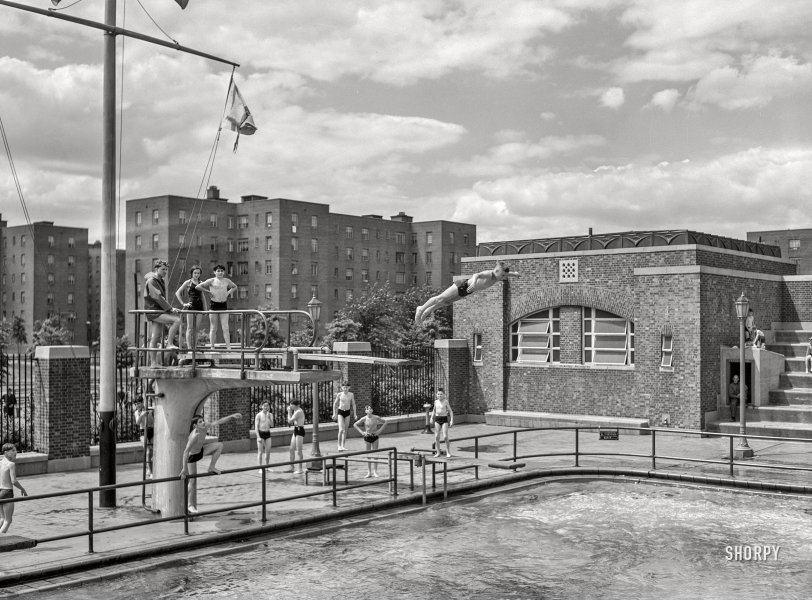


Framed or unframed, desk size to sofa size, printed by us in Arizona and Alabama since 2007. Explore now.
Shorpy is funded by you. Patreon contributors get an ad-free experience.
Learn more.

- Alas, hidden from view
- Exclusive pump
- Details, Details
- What's that building to the left of the tower?
- Coal Barges
- Bromo-Seltzer
- Inner harbor
- The Basin
- What a headache!
- Giant stepladder?
- Baldwin 62303
- Baldwin VO-1000
- Cold
- No expense spared
- Tough Guys
- Lost in Toyland
- And without gloves
- If I were a blindfolded time traveler
- Smoke Consumer Also Cooks
- Oh that stove!
- Possibly still there?
- What?!?
- $100 Reward
- Freeze Frame
- Texas Flyer wanted
- Just a Year Too Soon
- WWII -- Replacing men with women at the railroad crossing.
- Yes, Icing
- You kids drive me nuts!
- NOT An Easy Job
Print Emporium
Nine-Centers: 1942

June 1942. "Brooklyn, New York. Red Hook housing development. Diving pool at the play center which is supervised by the city's Department of Parks. There are separate pools for swimming and diving. Charge is nine cents for children, twenty-five cents for adults." Acetate negative by Arthur Rothstein for the Office of War Information. View full size.
Just a short walk down Clinton Street from where I am typing
is the Red Hook Play Center that houses this pool, now known as the Sol Goldman Recreation Center and Pool, named for the Brooklyn-born New York real estate magnate who in the 1970s provided funds to keep a number of New York City public pools open, including Red Hook. The aquatic facility was a WPA project opened in 1936 and is a designated New York City landmark. The diving pool shown is now a wading pool, and the buildings in the distance still exist, also WPA projects. It's undergone considerable refurbishment and renovation over the decades, and the pool is adjacent to playing fields on remediated industrial land south of the facility.
Nine?!?
Was one extra cent considered such a burden in 1942?
Besides the extra revenue, a dime would have saved a lot of labor, making change!
Boys will be
What is it with boys crawling all over everything? That kid on the rail under the lifeguard on the high diving board, the boys on the right on the roof of that entrance on the stairs, and all the others, tensed and ready for action -- they all seem to be burning off some kind of surplus energy.
Something Looked Off ...
I kept staring at this photo wondering what it was that looked out of place and it finally hit me. The kid climbing on that railing is dangerous enough but it occurred to me that I've never seen a railing around a pool before.
I wonder if this was a normal thing back then. There are so many things that make a railing dangerous. First and foremost, it impedes the path of a lifeguard and risks injury. It would also make it difficult to help someone out the pool and also end in injury. Someone walking close to the railing could slip on the wet tile and go head-first into a metal bar.
Sometimes I notice weird things but I don't know if it's worth pointing it out or not. Any public pool experts out there? HA!
What could go wrong?
Let's see -- there's a railing around this end of the pool to keep anyone from jumping in or climbing out there, avoiding collision with a diver.
But the young man directly under the high diving board has decided it would be fun to climb up on the round, metal rails with slippery, wet feet and, in one swift motion, push himself up with one leg and grab the underside of the diving platform. And then what? Best case scenario is he balances there for a moment or two and then lets go, diving into the water and avoids being hit by someone diving off the board directly above him. Worst case scenario is he gets to visit a local Brooklyn emergency room.
With the information provided by William Lafferty, above, I'm providing a birds eye view of the pool today. Gone are the pipe rail fence and diving boards, of course. Yet, I suspect Brooklyn yutes today are still able to risk serious injury doing foolish things.
























On Shorpy:
Today’s Top 5